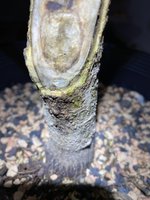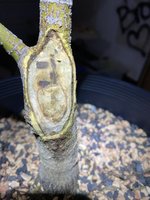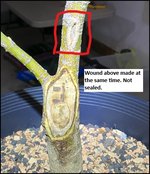RAB82
Seed
Hello All,
I'm new member to the forum, but long time forum reader from all my googling.
I have a wound on my Sharps Pygmy that seems to be progressing in the wrong direction. The wound is from a failed air layering done last June. Since then the wound and/or area surrounding the wound has grown and discolored. I sealed the wound after cutting, but continued to look worse. This year when examining the wound, it appeared to be discolored around the edges so I removed the pasted. The wood was moist underneath, which is what led to my assumption of poorly applied pasted job. I cleaned the cut and reapplied, in what I thought to be a more methodical and thorough process. I have been keeping an eye on it and started seeing more discoloration around it. I removed it again and found the wood to be, yet again, damp and looking like it was rotting. Last action was clean wound again and forget about the wound sealant.
I understand these things take time and I have not given it much of that, but given the result of the smaller wound above this major cut, I would have liked to see some sort of healing. My question is, is the discoloration below the cut of concern? If so, any thoughts on what is going on and how it can be treated?
Thanks in advance for any and all help/insight.
I'm new member to the forum, but long time forum reader from all my googling.
I have a wound on my Sharps Pygmy that seems to be progressing in the wrong direction. The wound is from a failed air layering done last June. Since then the wound and/or area surrounding the wound has grown and discolored. I sealed the wound after cutting, but continued to look worse. This year when examining the wound, it appeared to be discolored around the edges so I removed the pasted. The wood was moist underneath, which is what led to my assumption of poorly applied pasted job. I cleaned the cut and reapplied, in what I thought to be a more methodical and thorough process. I have been keeping an eye on it and started seeing more discoloration around it. I removed it again and found the wood to be, yet again, damp and looking like it was rotting. Last action was clean wound again and forget about the wound sealant.
I understand these things take time and I have not given it much of that, but given the result of the smaller wound above this major cut, I would have liked to see some sort of healing. My question is, is the discoloration below the cut of concern? If so, any thoughts on what is going on and how it can be treated?
Thanks in advance for any and all help/insight.



